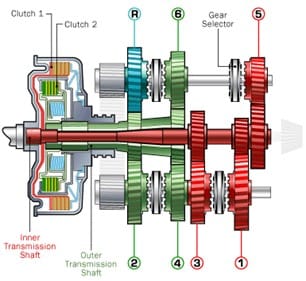Dual Clutch Automatic Transmission: All You Need To Know

Highlights
- DCT or dual-clutch automatic transmission is quick and meant for performance
- There are two clutches - one each for odd & even gears
- DCT is also known as DSG, within the VW Group
The evolving transmission systems can seem to be a complex subject if you do not follow the auto industry regularly. Over the years, different transmissions systems have made it to the market. Manual transmission has been around for the longest. However, it isn´t easy to drive and that forced automakers to consider alternatives. One such alternative is a dual-clutch automatic transmission. Before you head out to buy your next car, learn about dual-clutch automatic transmission and understand if it's the one for you. Let us explore more about this transmission system!
What Is Dual-Clutch Automatic Transmission (DCT)?
Dual Clutch Automatic Transmission is also referred to as Direct Shift Gearbox (DSG), by the VW Group. Most automakers have their unique version of DCT. However, they use DCT selectively across their range. Like so many innovations in vehicle transmission, the dual-clutch automatic transmission is a concept that has been there for years but is only new being out to use.
The Porsche 956, launched in 1983, was the first vehicle to sport a DCT. Several built-in computers help DCT to function. These computers prevent the need for manual inputs to shift gear. In other words, DCT automates the process of changing gears.

How Does Dual Clutch Transmission (DCT) Work?
With that introduction, you might have a fair idea about DCTs now. But, how does a dual-clutch transmission work? One of the primary benefits of DCT is that it minimises the time gap between changing gears.
In this transmission type, computerised clutches have a concentrical placement. Also, the crankshaft is connected to the clutch and is always ready to change to another. The countershafts have two cylindrical shafts that are independent. One of the countershafts in DCT is for even gear numbers, while the other is for odd.
The computer automatically anticipates the following gear ratio when the output shaft runs at a specific gear ratio. For this purpose, the computers analyse acceleration, deceleration, engine speed, and ongoing speed.

Pros of Dual Clutch Transmission (DCT)
Several benefits of opting for a vehicle with a dual clutch automatic transmission. We have discussed a few below:
- DCTs tend to offer better fuel efficiency than other automatic transmissions. It also delivers a smoother and seamless performance.
- Owing to their fuel efficiency and high-quality performance, many fleet owners prefer DCTs. Due to these advantages, DCTs are also ideal for significant long-term savings.
- Since they allow to shift gears smoothly and swiftly, the dual-clutch automatic transmission has also found its place in performance driving.

Cons of Dual Clutch Transmission (DCT)
Each type of transmission comes with its cons. However, the cons of DCT are pretty easy to navigate over time. In any case, let's look at the setbacks of dual-clutch automatic transmission:
- Most car owners claim that DCT is more complex than other transmission systems.
- Also, DCT takes more room under the hood than any other transmission system.














